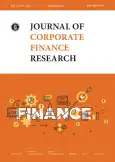ESG-risk Factors and Value Multiplier of Telecommunications Companies
- Authors: Khorin A.1, Krikunov A.1
-
Affiliations:
- МГУ
- Issue: Vol 15, No 4 (2021)
- Pages: 56-65
- Section: New Research
- URL: https://journal-vniispk.ru/2073-0438/article/view/303432
- DOI: https://doi.org/10.17323/j.jcfr.2073-0438.15.4.2021.56-65
- ID: 303432
Cite item
Full Text
Abstract
The paper is devoted to the study of the impact of environmental, social responsibility and corporate governance (ESG) risk factors on the value of telecommunications industry enterprises expressed through the EV_EBITDA multiplier. The main goal was to assess the elimination of ESG risks from the standpoint of increasing the competitiveness of the company. The methodological basis of the study was the coordination of non-financial information of companies with their financial results. The paper implements the construction of a regression model within the framework of econometric modeling, the direction of which was proposed by A. Damodaran. The authors did not limit themselves to corporate information from one country, but identified five regions, such as the USA, the European Union, the UK, the rest of the developed countries (DEV), as well as the markets of developing countries (EM). The database was compiled on the basis of non-financial business activity parameters of 57 of the world's largest telecommunications companies as of 2021, where financial information is taken from the Bloomberg database, and the ESG risk coefficient of the rating of these companies is used from the Sustainalytics research center. The result of the study was that there is a stable relationship between the risk of the ESG rating and the EV/EBITDA parameter characterizing the cost of capital – that is, the lower the risk, the greater the cost of capital. For different country groups, the result was obtained with varying degrees of confidence: for "other developed countries" with a high 5% significance level, for European countries with a 10% level, for the USA, the insignificance of the coefficient is associated with a small sample size, and for developing country markets the coefficient is insignificant. The novelty of the results obtained lies in the use of a metric approach to confirm the stable dependence of ESG risk factors on the EV/EBITDA cost multiplier. The results obtained allow us to make a generalized conclusion that the elimination of ESG risks contributes to the growth of the company's competitiveness, where the results of the study are able to encourage companies to consider the disclosure of non-financial information as an important indicator of long-term sustainability. When ESG is considered as an integral factor in the future activity of the company, the end result is its higher evaluation by stakeholders.
About the authors
A. Khorin
МГУ
Author for correspondence.
Email: anhorin@mail.ru
A. Krikunov
Email: s.krikunof@yandex.ru
References
- Wu T.C., Tsaur C.C., Lin C.H., Shiau S.Y. Surveying safety culture in telecommunications industry. Journal of Occupational Safety and Health. 2011;4(19):403–420.
- Ruiz-Canela López J. How can enterprise risk management help in evaluating the operational risks for a telecommunications company? Journal of Risk and Financial Management. 2021;14(3):139. https://doi.org/10.3390/jrfm14030139
- Yesuf A.S. A review of risk identification approaches in the telecommunication domain. In: Proc. 3rd Int. Conf. on Information Systems Security and Privacy (ICISSP 2017) (Porto, Feb. 19–21, 2017). Lisboa: INSTICC; 2017:389–396. https://doi.org/10.5220/0006197603890396
- Gandini G., Bosetti L., Almici A. Risk management and sustainable development of telecommunications companies. Symphonya: Emerging Issues in Management. 2014;(2):16–29. http://dx.doi.org/10.4468/2014.2.03gandini.bosetti.almici
- Pakhchanyan S. Operational risk management in financial institutions: A literature review. International Journal of Financial Studies. 2016;4(4):20. https://doi.org/10.3390/ijfs4040020
- MacDonald D.B. When risk management collides with enterprise sustainability. Journal of Leadership, Accountability & Ethics. 2011;8(3):56–66.
- Salvioni D.M. Governance, risk management and business effectiveness in global firm. In: Tipurić D., Dabić M., eds. Management, Governance, and Entrepreneurship: New Perspective and Challenges. Darwen: Access Press; 2012.
- McShane M.K., Nair A., Rustambekov E. Does enterprise risk management increase firm value? Journal of Accounting, Auditing and Finance. 2011;26(4):41–58. https://doi.org/10.1177/0148558X11409160
- Monda B., Giorgino M. An ERM maturity model. In: 2013 Enterprise Risk Management Symposium (Chicago, Apr. 22–24, 2013). Schaumburg, IL: Society of Actuaries; 2013. URL: https://web.actuaries.ie/sites/default/files/erm-resources/50_ERM_maturity_model.pdf.pdf
- Kumar P.C. ESG compliant companies provide superior returns. The Star. Feb. 29, 2020. URL: https://www.thestar.com.my/business/business-news/2020/02/29/esg-compliant-companies-provide-superior-returns
- Friede G., Busch T., Bassen A. ESG and financial performance: Aggregated evidence from more than 2000 empirical studies. Journal of Sustainable Finance and Investment. 2015;5(4):210–233. https://doi.org/10.1080/20430795.2015.1118917
- Noronha C., Guan J., Fan J. Firm value and social contribution with the interaction of corporate governance: Social contribution value per share. Sustainability Accounting, Management and Policy Journal. 2018;9(2):165–200. https://doi.org/10.1108/SAMPJ-10-2016-0078
- Buallay A. Is sustainability reporting (ESG) associated with performance? Evidence from the European banking sector. Management of Environmental Quality. 2019;30(1):98–115. https://doi.org/10.1108/MEQ-12-2017-0149
- Porter M., Serafeim G., Kramer M. Where ESG fails. Institutional Investor. Oct. 16, 2019. URL: https://www.institutionalinvestor.com/article/b1hm5ghqtxj9s7/Where-ESG-Fails
- Duque-Grisales E., Aguilera-Caracuel J. Environmental, social and governance ESG scores and financial performance of multinationals: Moderating effects of geographic international diversification and financial slack. Journal of Business Ethics. 2021;168(2):315–334. https://doi.org/10.1007/s10551-019-04177-w
- Radhouane I., Nekhili M., Nagati H., Paché G. Is voluntary external assurance relevant for the valuation of environmental reporting by firms in environmentally sensitive industries? Sustainability Accounting, Management and Policy Journal. 2020;11(1):65–98. https://doi.org/10.1108/SAMPJ-06-2018-0158
- Buallay A., Fadel S.M., Alajmi J., Saudagaran S. Sustainability reporting and bank performance after financial crisis: Evidence from developed and developing countries. Competitiveness Review. 2021;31(4):747–770. https://doi.org/10.1108/CR-04-2019-0040
- Saurabh S. Economic value added for competitive advantage: A case of Indian enterprises. Newcastle upon Tyne: Cambridge Scholars Publishing; 2019. 176 p.
- Khorin A., Bulgakov A., Krikunov A. Financial effects of corporate social responsibility and information transparency: Research in the pharmaceutical industry. Korporativnye finansy = Journal of Corporate Finance Research. 2020;14(1):29–38. https://doi.org/10.17323/j.jcfr.2073-0438.14.1.2020.29-38
- Bulgakov A. Big Data in finance. Korporativnye finansy = Journal of Corporate Finance Research. 2017;11(1):7–15. (In Russ.). https://doi.org/10.17323/j.jcfr.2073-0438.11.1.2017.7-15
- Company ESG risk ratings. Morningstar Company. Sustainalytics. URL: https://www.sustainalytics.com/esg-ratings (accessed on 30.06.2021).
Supplementary files










